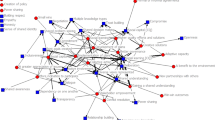Abstract
Methods for involving the public in natural resource management are changing as agencies adjust to an increasingly turbulent social and political environment. There is growing interest among managers and scholars in collaborative approaches to public involvement. Collaboration is conceptually defined and elaborated using examples from the natural resource management field. This paper then examines how collaboration theory from the organizational behavior field can help environmental managers to better understand those factors that facilitate and inhibit collaborative solutions to resource problems. A process-oriented model is presented that proposes that collaboration emerges out of an environmental context and then proceeds sequentially through a problem-setting, direction-setting, and structuring phase. Factors constraining collaboration are also specified, including organizational culture and power differentials. Designs for managing collaboration are identified, which include appreciative planning, joint agreements, dialogues, and negotiated settlements. Environmental managers need new skills to manage collaboration within a dynamic social and political environment. Further research is needed to test the propositions outlined here.
Similar content being viewed by others
Literature Cited
Ackoff, R. L. 1974. Redesigning the future. Wiley, New York.
America's Great Outdoor. 1991.National Recreation Strategy Newsletter 2:1–27. USDA Forest Service, Washington, DC.
Ashor, J. L., S. F. McCool, and G. L. Stokes. 1986. Improving wildreness planning efforts: Application of the transactive planning approach. Intermountain Research Station, Ogden, Utah.
Baskerville, G., 1988. Management of publicly owned forests.Forest Chronicle 64:136–140.
Bishop, S. G. 1991. Partners for research and resource management. Partners in Parks, Henderson, Nevada.
Bonnicksen, T. M. 1991. Managing biosocial systems.Journal of Forestry October: 10–15.
Clower, C. M., J. D. Forren, J. W. Rawson, K. J. Bonner. 1993. Canaan Valley: A watershed protection approach. Proceedings of watershed 93: A national conference on watershed management. United States Fish and Wildlife Service. Alexandria, Virginia.
Crowley, K. 1988. Teamwork: Resorts and the Forest Service.Parks and Recreation August:38–40.
Freeman, R. E. 1984. Strategic management: A stakeholder approach. Pitman Publishing, Marshfield, Massachusetts.
Gray, B. 1985. Conditions facilitating interorganizational collaboration.Human Relations 38(10):911–936.
Gray, B. 1989. Collaborating: Finding common ground for multiparty problems. Jossey-Bass, San Franciso.
Hayes, S. 1988. What's wrong with mediations?Sylvanian Feb–Mar:2.
Longan, M. 1988. Smokey the Bear meets Ronald McDonald.Parks and Recreation September:62–83.
McCann, J. E. 1983. Design guidelines for social problem-solving interventions.Journal of Applied Behavioral Sciences 9(2):177–192.
Nelson, R. D., and Raml, T. A. 1989. Join us: Challenge cost-share for wildlife and fisheries on national forests. Proceedings of the fifty-fourth North American wildlife and natural resources conference. Wildlife Management Institute, Washington, DC.
Rao, K., and C. Geisler. 1990. The social consequences of protected areas development for resident people.Society and Natural Resources 3(1):19–32.
Schatz, C., L. H. McAvoy, and D. W. Lime. 1991. Cooperation in resource management: A model planning process for promoting partnerships between resource managers and private service providers.Journal of Park and Recreation Administration 9(4):42–58.
Selin, S. W., and K. Beason. 1991. Interorganizational relations in tourism.Annals of Tourism Research 18(4):639–652.
Selin, S. W., and D. Chavez. 1993. Recreation partnerships and the USDA Forest Service.Journal of Park and Recreation Administration 11(1):1–8.
Sirmon, J, W. E. Shands, and C. Liggett. 1993. Communities of interests and open decisionmaking.Journal of Forestry 91(7):17–21.
Stewart, W. P., J. S. Sullivan, J. M. Packard, and S. B. Anderson. 1991. Tourism development in rural areas of the American west. Proceedings of leisure research symposium. National Recreation and Park Association, Alexandria, Virginia.
Tanz, J. S., and A. F. Howard. 1991. Meaningul public participation in the planning and management of publicly owned forests.The Forestry Chronide 67(2):125–130.
Waddock, S.A., 1989. Understanding social partnerships: An evolutionary model of partnership organizations.Administration and Society 21(1):78–100.
Whitelaw, E., and E. Niemi. 1993. After the owl.Old Oregon Winter: 26–29.
Wondolleck, J. M. 1988. Public lands conflict and resolution. Plenum Press, New York.
Author information
Authors and Affiliations
Rights and permissions
About this article
Cite this article
Selin, S., Chevez, D. Developing a collaborative model for environmental planning and management. Environmental Management 19, 189–195 (1995). https://doi.org/10.1007/BF02471990
Issue Date:
DOI: https://doi.org/10.1007/BF02471990




